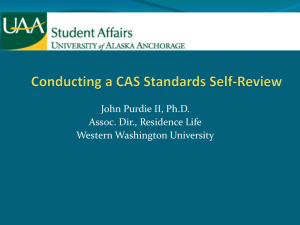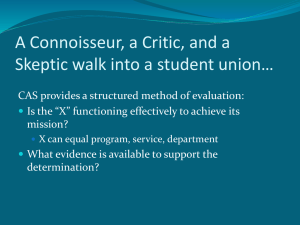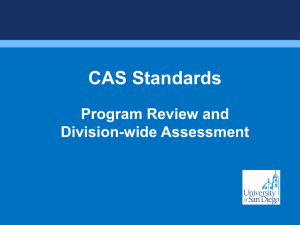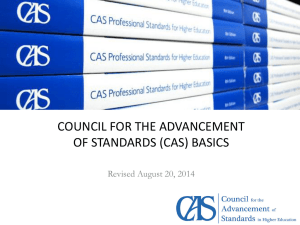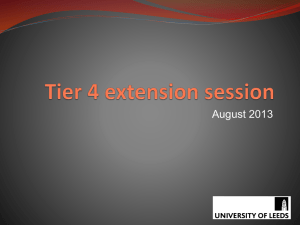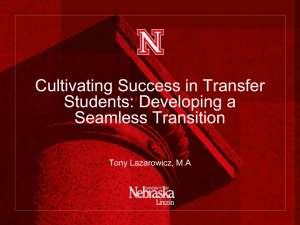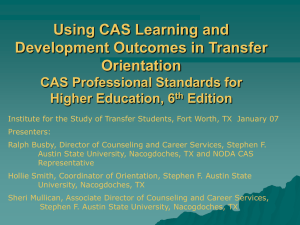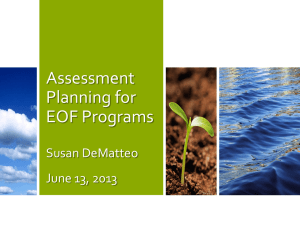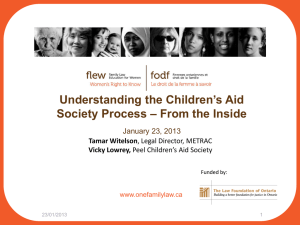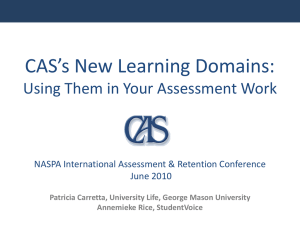CAS Standards
advertisement
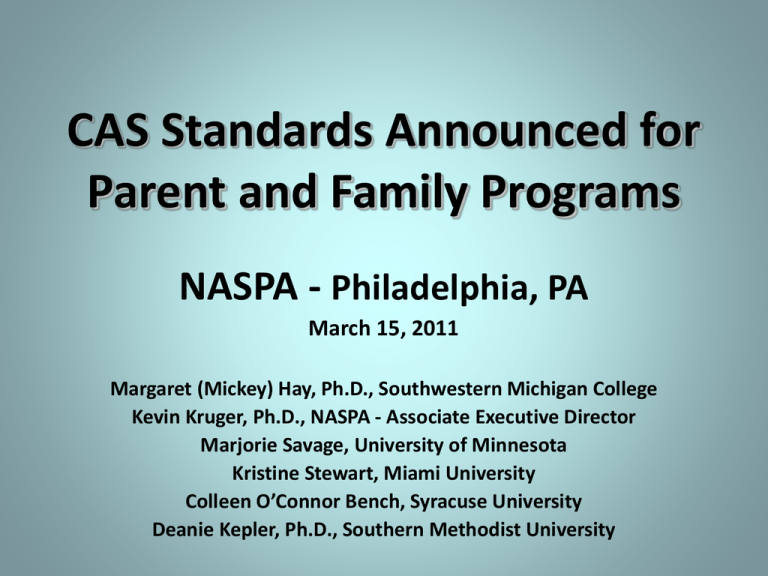
CAS Standards Announced for Parent and Family Programs NASPA - Philadelphia, PA March 15, 2011 Margaret (Mickey) Hay, Ph.D., Southwestern Michigan College Kevin Kruger, Ph.D., NASPA - Associate Executive Director Marjorie Savage, University of Minnesota Kristine Stewart, Miami University Colleen O’Connor Bench, Syracuse University Deanie Kepler, Ph.D., Southern Methodist University CAS Council for the Advancement of Standards in Higher Education • • • • Founded in 1979 Consortium of 38 professional organizations Constituency of over 100,000 Member associations send representatives to the CAS Board of Directors • Consensus-oriented, collaborative • Focused on quality programs and services for students • Guide practice by student affairs, student development, and student support service providers CAS Mission • Establish, adopt, and disseminate professional standards to guide student learning and development programs and services • Promote assessment and improvement of higher education programs and services through self-study • Establish, adopt, and disseminate professional preparation standards for student affairs practitioners, and promote assessment and improvement of graduate programs • Advance use and importance of professional standards • Develop and provide materials to support the use of standards • Promote and encourage focus on quality assurance • Promote inter-association efforts to address these issues CAS Philosophy 1. Higher education must dynamically seek continuous quality enhancement of all services and programs 2. Quality is foundationally grounded in standards 3. Standards become basis of desired student outcomes that address the whole student 4. These learning and developmental outcomes are established through self-assessment 5. Assessment must loop back to continuous quality enhancement action interventions Komives, National CAS Symposium, November 14, 2006 Uses of the CAS Standards • Measures of program and service effectiveness • Institutional self-studies • Preparation for accreditation • Design new programs and services • Staff development • Academic preparation • Credibility and accountability Functional Areas • CAS standards and guidelines generally are targeted to individual functional areas. Functional Areas are specialized or focused educational programs and services generally arranged into distinctive administrative units within an institution of higher education. • Standards and guidelines present criteria describing the fundamental essential expectations of practice agreed upon by the profession at large for a given institutional function. CAS Resources • • • • CAS Professional Standards, 2009 edition Self-Assessment Guides CAS Statement of Shared Ethical Principles CAS Characteristics of Individual Excellence • Frameworks for Assessing Learning and Development Outcomes CAS Guiding Principles • Students and Their Institutions • Diversity and Multiculturalism • Organization, Leadership, and Human Resources • Health Engendering Environments • Ethical Considerations CAS Essentials • The CAS Standards (big blue book) provide an important tool that expresses to students, faculty, and administrators the complex and vital nature of student support programs and services, and their relationship to student learning and development. Standards are agreed upon conditions of educational service that must be provided to achieve the highest level of service to students. • The Self Assessment Guides are used to gain informed perspectives on the strengths and deficiencies of programs and services and to plan for improvements. Guidelines are recommended enhancements that should be included in all services to students, but are not required to meet minimal benchmarks. General Standards • Mission • Program (Student Learning and Development Outcomes) • • • • • Leadership Human Resources Ethics Legal Responsibilities Equity and Access • Diversity • Organization and Management • Campus and External Relations • Financial Resources • Technology • Facilities and Equipment • Assessment and Evaluation Standards • Indispensible requirements • Achievable by any and all programs of quality • Appear in bold type • Use verbs Must and Shall vs. Guidelines • Clarify and amplify standards • Guide enhanced practice beyond essential function • Appear in light-faced type • Use verbs Should and May Expectations of Functional Areas • Must promote student learning and development outcomes • Must identify relevant and desirable student learning & development outcomes • Must assess outcomes • Must provide evidence of their impact on student learning and development • Must articulate how they contribute to or support student learning and development Parent and Family Programs (PFP) Standards • Accepted April 2010 • Available from www.cas.edu for $15 • SAGs available as well for $35 (RTF format) • Let’s take a peek! Selected text - Mission • The mission of Parent and Family Programs (PFP) is to build collaboration between parents and families and the institution for the common goals of student learning, development, and success. • PFP must develop, disseminate, implement, and regularly review their mission. Mission statements must be consistent with the mission of the institution and with professional standards. PFP in higher education must enhance overall educational experiences by incorporating student learning and development outcomes in their mission. • Inherent in the mission statement should be a vision for students and their families to develop lifelong affinity for the institution and its initiatives. Selected text - Program PFP must be: • integrated into the life of the institution • intentional and coherent • guided by theories and knowledge of learning and development • reflective of developmental and demographic profiles of the student population served • responsive to needs of individuals, diverse and special populations, and relevant constituencies Programming and services may include parent and family orientation programs, parent and family weekends, move-in and send-off events, educational workshops and seminars, newsletters, and fundraising. Other programs should be specifically reflective of the institutional history, traditions, and culture. Selected text – Human Resources • Parent and Family Programs (PFP) must be staffed adequately by individuals qualified to accomplish the mission and goals. Within institutional guidelines, PFP must establish procedures for staff selection, training, and evaluation; set expectations for supervision; and provide appropriate professional development opportunities to improve the leadership ability, competence, and skills of all employees. • PFP staff should include full-time professionals. • PFP should have sufficient and specifically trained staff to support technology including the maintenance of program websites, social networks, communications systems, and developing emerging technology. Selected text – Equity & Access • Parent and Family Programs (PFP) must be provided on a fair, equitable, and non-discriminatory basis in accordance with institutional policies and with all applicable state/provincial and federal statutes and regulations. PFP must maintain an educational and work environment free from discrimination in accordance with law and institutional policy. • PFP should include statements related to disability and equal opportunity laws in all print and electronic materials in accordance with institutional policy. Selected text - Facilities • PFP staff members must have work space that is wellequipped, adequate in size, and designed to support their work and responsibilities. For conversations requiring privacy, staff members must have access to a private space. • The design of the facilities must guarantee the security of records and ensure the confidentiality of sensitive information. • PFP must ensure staff members are knowledgeable of and trained in safety and emergency procedures for securing and vacating facilities. Response/Comments from “seasoned professionals” Syracuse University • 2006 CAS assessment: SU Parents Office • Subsequent qualitative analysis: interactions w/parents & families of underrepresented populations Response/Comments from “seasoned professionals” Miami University of Ohio Student Voice project: • Surveys first-year parents before summer orientation through Commencement • Focus on interaction b/t parent & student with regard to behavioral changes of both • Survey Question examples • Shared system; ability to network data to other universities working on assessment issues Self-Assessment Guide - SAG Purpose • To gain perspectives on strengths and deficiencies of programs and services • To plan for improvements The CAS SAG: A Self-Assessment Guide • Translates CAS standards into an effective workbook / evaluative format • Promotes program self-assessment and development • Informs on program strengths and weaknesses • Supports professional staff development • Leads to enhanced programs and services that benefit student learning and development Self-Assessment Guide Components • Review team, team leader – Staff, faculty, students, parents • Program documentation – Mission/vision statements, print and web materials, staff manuals, policy and procedure statements, evaluation and periodic reports CAS Self-Assessment Process 1. Establish and prepare the self-assessment team 2. Initiate the self study 3. Compile and review documentary and evaluative evidence 4. Identify discrepancies 5. Determine appropriate corrective action 6. Recommend steps for program enhancement 7. Prepare an action plan Self-Assessment Guide Assessment process Steps • Rate on scale • Assess each criteria • Review with interested parties • Develop action plan to enhance program – – – – – – Not done Not met Minimally met Well met Fully met Not rated Self-Assessment Guide - Mission ND 1 2 3 4 NR Not Done Not Met Minimally Met Well Met Fully Met Not Rated Criterion Measures 1.1 The program develops, disseminates, and implements its mission. 1.2 The program regularly reviews its mission. 1.3 The mission statement is consistent with that of the host institution and with professional standards. 1.4 The program enhances overall educational experiences by incorporating learning and development outcome domains in the mission statement. Rating Self-Assessment Guide • • • • • Identify areas of strength Identify areas of weakness Identify actions to implement Prioritize recommended actions Prepare comprehensive implementation plan – – – – Identify resources (i.e., human, fiscal, physical) Establish timeline for specific actions Identify responsible parties for action steps Set tentative date for the next self-study Questions and Discussion

